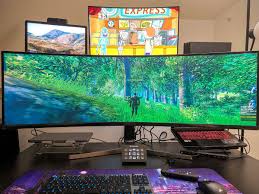
The Essential Guide to Monitors
Monitors are an essential component of any computer setup, serving as the primary interface through which users interact with their devices. From traditional CRT monitors to modern LCD and LED displays, the evolution of monitor technology has been remarkable.
Types of Monitors
There are several types of monitors available on the market today:
- CRT Monitors: Cathode Ray Tube monitors were once the standard in display technology, but have largely been replaced by newer technologies.
- LCD Monitors: Liquid Crystal Display monitors are thin, lightweight, and energy-efficient, making them popular for a wide range of applications.
- LED Monitors: Light Emitting Diode monitors offer improved brightness and color accuracy compared to traditional LCD displays.
- Gaming Monitors: Designed for high-performance gaming, these monitors often feature high refresh rates and low response times for a smooth gaming experience.
Choosing the Right Monitor
When selecting a monitor, consider factors such as resolution, screen size, refresh rate, and panel type. Higher resolution displays offer sharper image quality, while larger screens provide more screen real estate for multitasking. Gamers may prioritize refresh rate and response time for a competitive edge.
Maintenance and Care
To ensure optimal performance and longevity of your monitor, follow these maintenance tips:
- Clean the screen regularly with a soft, lint-free cloth.
- Avoid exposing the monitor to direct sunlight or extreme temperatures.
- Adjust brightness and contrast settings for comfortable viewing.
- Use a screen saver to prevent image burn-in on static displays.
Conclusion
Monitors play a crucial role in our daily computing activities, providing us with visual feedback and enhancing our overall user experience. By understanding the different types of monitors available and how to care for them properly, you can make informed decisions when choosing a monitor that best suits your needs.
Essential FAQs About Choosing the Right Monitor
- What are the three 3 types of monitors?
- What is a monitor used for?
- What type of monitors are the best?
- How expensive should a monitor be?
What are the three 3 types of monitors?
When it comes to monitors, there are three main types that are commonly used: CRT (Cathode Ray Tube) monitors, LCD (Liquid Crystal Display) monitors, and LED (Light Emitting Diode) monitors. Each type has its own set of characteristics and advantages. CRT monitors were once the standard but have been largely replaced by the thinner and more energy-efficient LCD monitors. LED monitors, a variation of LCD technology, offer improved brightness and color accuracy. Understanding the differences between these monitor types can help users make informed decisions when choosing the right display for their computing needs.
What is a monitor used for?
A monitor is a display device that is used to visually output information from a computer or other electronic device. It serves as the primary interface through which users can view text, images, videos, and other visual content generated by their devices. Monitors play a crucial role in various applications, including web browsing, document editing, gaming, graphic design, video editing, and more. Essentially, a monitor acts as a window into the digital world, allowing users to interact with and consume content in a visual format.
What type of monitors are the best?
When it comes to determining the best type of monitor, the answer largely depends on individual preferences and specific use cases. Factors such as resolution, screen size, refresh rate, panel type, and budget all play a role in selecting the ideal monitor for your needs. Gamers may prioritize high refresh rates and low response times for a smooth gaming experience, while graphic designers may value color accuracy and high resolution displays. LED monitors are known for their brightness and energy efficiency, while LCD monitors offer a balance of performance and affordability. Ultimately, the best monitor is one that meets your specific requirements and enhances your overall computing experience.
How expensive should a monitor be?
The cost of a monitor can vary widely depending on factors such as brand, size, resolution, and features. When determining how much to spend on a monitor, it’s important to consider your specific needs and budget. For basic tasks like web browsing and office work, a budget-friendly monitor with standard features may suffice. However, if you require higher resolution for graphic design or gaming, investing in a more expensive monitor with advanced specifications could enhance your user experience. Ultimately, the price of a monitor should align with your usage requirements and preferences to ensure that you get the best value for your money.
